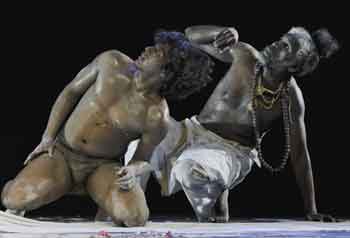INVC NEWS
New Delhi,
Day four of BRM witnessed colours of theatre through the day long events. The Dias opened questions for directors of Taj Mahal ka Tender, Priyotamasu and Kumari and the Beast. Facilitating the discussion, the Dias was first opened to the director of Taj Mahal ka Tender, Dir. Chittaranjan Tripathy who opened about the intricacies of his comic-satire and then answered some of the questions from the students. Priyotamasu’s Dir. & Wri. Prithu Nandan Ghose, who while talking about his production explained that the marriage took place due to the love for the woman not out of sympathy. Kumari and the Beast Dir. And Wri. Kavita Srinivasan, has an aim to humanise the godly characters to make it more accessible to the audience. The play is set on the concept of Kumari’s from Nepal. As fillers Bhaand and Assamese dance Bihu were performed by Punjab Academy and Shayam Arts, respectively.
Today’s Play
BURY THE DEAD
This is a story of an unknown place and time where a war is being fought for the past two years. On the aforesaid day six soldiers who were killed two days ago are being buried in the battlefield. Suddenly, these soldiers rise and refuse to be buried. These dead soldiers have their own logic i.e. that wars are fought and the common man dies to feed the ambitions, business and greed of a handful of power-hungry people. The corpses say that they wish to live… the life of a farmer, of a son, with friends, with their beloved… enjoying nature, relationships and beauty that this life is endowed with. The women from their homes are called to convince them but that too doesn’t work. In the end the general tries to blow them with a machine gun but the corpses come out of their graves and stand amidst the people, thus underlining the importance of life, and drawing the attention towards the horrors of war generated by sheer greed.
NUPI GEETHAMAI (Shumang Leela)
Prince Nothing Khong was the third son of emperor Urakonthouba of Manipur (568-663 AD). A Stubborn young man, he ran away to the hills where he found Petanga, a beautiful girl who was the only child of Shelloi village chief. Nothing Khong married Petanga secretly and promised her that she would be the queen of Manipur when he sat on the throne. The villagers revolted and wished to kill Naothingkhong because his father was a bitter enemy o
f the clan. So he escaped from the house of Petanga and sought asylum under the patronage of Khuman King. Petangawas punished by her own people and had to escape.Naothingkhong ascended the Khumanthrone and married the Khuman princess. No sooner did Petangaget the news, she invoked the goddess YumjaoLairembi and vanished with her last words of lament, “man has no power to realise true love”.
GHORAMUKHO PALA (THE HORSE-FACED OPERA)
Kapil and Devdutta of Dharmapur are the heroes of our play. One comes from a Brahmin family and the other is a blacksmith’s son. Devdutta falls in love with the daughter of a gold-merchant, Padmini. He vows that if he marries Padmini, he would sacrifice his hands to Ma Kali, and his head to Rudra Dev. Eventually, Devdutta marries Padmini. They visit Ujjayini when Padmini is pregnant. Devdutta becomes furious when he discovers the intimacy between Kapil and Padmini. Sending Kapil and Padmini to the Rudra temple, he goes to the Kali temple and cuts his head off near the feet of Ma Kali. When Kapil returns, he sacrifices his life seeing his friend lying beheaded. Padmini too moves to do the same but Goddess Kali appears and stops her. Abiding by the direction of the goddess, she fixes the heads of Kapil and Devdutta, but on each other’s body. Although the two friends are offered life again by the grace of Ma, their heads are transposed…
VAST
This is the story of a young boy from Nepal who has been abducted and taken away from his family and home in the Himalayan Mountains. Kidnapped and abused, he now lives in a slum in a big city in India. He is all alone in the world, living stifled in his small room. He tries, day after day, to find in his body a door that opens to the ‘Vast’, a path to his Himalaya, and his own limitless nature, beyond confinement and misery. A nen counter with a strange character helps him on his journey. This is the god Hanuman, with monkey and human features, heroic, wise, and full of humour. Vast is an organic, physical and dance based performance that is hypnotic, emotional and universal. It showcases how the human body carries in itself the memory of the ‘Vast’. How the human body–beyond ruptures, oppression and confinements–has the nostalgia of nature and vastness.











